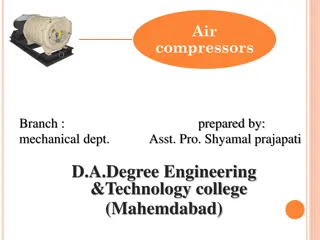Overview of Biosensors: Applications and Types
Biosensors are advanced analytical devices that convert biological responses into quantifiable signals, comprising bioreceptors and transducers. They play a crucial role in various fields, meeting specific requirements for accuracy, reproducibility, and ease of use. Different types of biosensors such as electrochemical and optical are utilized based on their transduction mode. These biosensors find applications in industries due to their specificity, portability, and cost-effectiveness. Understanding their classifications and functionalities is essential for utilizing biosensors effectively in various domains.
Download Presentation

Please find below an Image/Link to download the presentation.
The content on the website is provided AS IS for your information and personal use only. It may not be sold, licensed, or shared on other websites without obtaining consent from the author.If you encounter any issues during the download, it is possible that the publisher has removed the file from their server.
You are allowed to download the files provided on this website for personal or commercial use, subject to the condition that they are used lawfully. All files are the property of their respective owners.
The content on the website is provided AS IS for your information and personal use only. It may not be sold, licensed, or shared on other websites without obtaining consent from the author.
E N D
Presentation Transcript
DR. SALILSINGH (LECTURER) SCHOOL OF STUDIES IN ZOOLOGY & BIOTECHNOLOGY VIKRAM UNIVERSITY, UJJAIN LECTURE FOR M.SC. BIOTECHNOLOGY, SEMESTER IIND STUDENTS PAPER IST- ENZYME TECHNOLOGY UNIT-IV TOPIOC- BIOSENSOR
Introduction Biosensors are analytical devices that convert a biological response into a quantifiable and processable signal. The main components of a typical biosensor are the bioreceptor, which specifically interacts with the target analyte, and the transducer, which converts this interaction into an electronic signal. The transducer response can then be further amplified by a detector curcit, processed, and displayed. A biosensor is therefore a self-contained integrated device that combines a biological recognition element with a physical transducer. According to the type of transducer, biosensors can be classified as electrochemical biosensor, calorimetric biosensors, optical biosensors, and piezoelectric biosensors.
To be implemented in the industry, biosensors must meet a series of key requirements, which are - 1. The bioreceptor must be highly specific for the purpose of the analysis; stable under normal storage conditions; and show a low variation between assays. 2. The response should be accurate, precise, reproducible, linear over the useful analytical range (ideally), and require minimal sample pretreatment (e.g., dilution or concentration). 3. The detected reaction should be independent from physical parameters, such as pH and temperature. This will allow analysis with minimal pretreatment of samples. 4. The complete biosensor should be cheap, small, portable, and simple enough to be used by semiskilled operators.
Types of Biosensors Biosensors can be classified according to the mode of physicochemical transduction or the type of biorecognition element. Based on the transducer, biosensors can be classified as electrochemical, optical, thermal, and piezoelectric biosensors . Electrochemical Electrochemical biosensor measure the current produced during oxidation or reduction of electro active product or reactant),potentiometric biosensors (that measure the potential of the biosensor electrode with respect to a reference electrode), and conductometric biosensors (that measure the change in conductance arising due to the biochemical reaction). Electrochemical biosensors are the most extensively investigated biosensors as they offer the advantage of low detection limit, specificity, simplicity of construction, and ease of operation. Owing to recent advances in electronic instrumentation, these biosensors can be miniaturized as lab-on-chip devices for in vivo monitoring or as handheld device for on-site monitoring . biosensor can be further classified as amperometric biosensors (that
Optical Optical biosensors biosensors rely on measurement of light absorbed or emitted as a consequence of a biochemical reaction. Optical biosensors are based on various optical techniques such as absorption, fluorescence, luminescence, surface plasmon resonance (SPR), etc. . Among these, the colorimetric biosensors are extensively explored due to ease of detection of the visible color change shown by these biosensors. Plasmonic properties of noble metal films are utilized for SPR-based biosensors. The advent of fiber optics technology has given a boost to development of various optical biosensors.
Thermal Thermal biosensors biosensors are based on measurement of the thermal changes occurring on biochemical recognition. Most of the biochemical reaction involve a change in enthalpy and the heat changes can be measured by sensitive thermostats. Piezoelectric Piezoelectric biosensors of biomolecular interaction. Piezoelectric crystals are employed to measure the mass change by correlating with the change in oscillation frequency of the piezo crystal. biosensors involve measurement of mass change occurring as a result Based on the type of biorecognition unit used, biosensors can be classified as enzymatic, nucleic acid based, aptamer-based, antibody-based, whole cell based biosensors .























